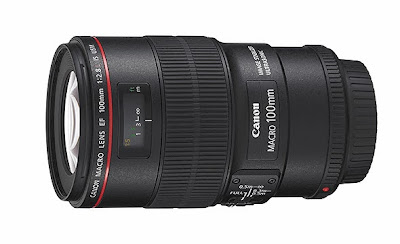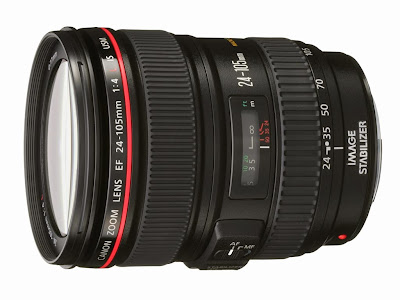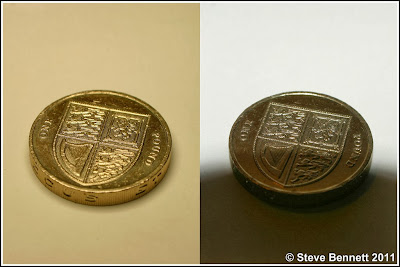 |
| Macro Lenses |
What is a macro lens?
There are many lenses out there in the market which have a symbol of a small flower indicating macro. However those lenses are not macro lenses in true sense. In order to qualify as a true macro lens it should be able to produce life size (1:1) magnification on the camera sensor. Any lens which is capable of reasonable subject magnification but is not capable of achieving 1:1 is called close up lenses and not macro lenses.
What is Life Size (1:1) Magnification?
Magnification or magnification ratio is the ratio between the size of the subject (in focus at the closest focusing distance) and its size on the image sensor. So if a subject measuring 1cm in reality appears the same size in the sensor it is called life size or 1:1 magnification.
 |
| Lens magnification |
If an object is 100cm in reality but its projected size is only 1cm on the image sensor then magnification of the lens will be 1cm/100cm or 1/100. Similarly if a subject that is 10cm long and its projected size is only 2cm on the image sensor then the lens magnification will be 2cm/10cm or 2/10.
Magnification of lenses is notated using a colon; so the above examples will be noted as 1:100 and 2:10 respectively.
A ratio of 2:10 means that in reality the subject is five times larger than its projection on the image sensor.
Macro Lenses are Flat Field Lenses
Generally all lenses except macro lenses are curved field lenses and images shot with them will have a field curvature; meaning the point of focus will be slightly different at the corners than the center.
 |
| Flat Field Lens |
In the illustration given above first one is a normal lens which has a curved field and as a result if you focus the lens on the green star in the center, then the stars on the corners will be out of focus due to the field curvature of the lens. If the stars were in the position indicated by the red stars then they would be in focus too.
The second lens in the illustration is a flat field lens and you could see that all the three stars, the one in the center and those towards the corners are all in sharp focus. This is extremely important when photographing small objects such as postage stamps as we need to get both the center and corners in sharp focus.
Having a flat field lens might not be that important for other types of photography, some genres of photography like portraiture could actually benefit from a little field curvature and in certain situations it is also possible to reduce the side effects of field curvature by stopping down the lens to a narrow aperture. But this is not possible in all situations and depending on the lens you're using and how close the lens is to your subject, the edges might still be soft even after you stop down to smaller apertures.
Magnification and Sensor Size
Before going into details let us first clarify one important point which many people often confuse; when we talk about magnification of macro lenses we are actually referring to the magnification at the sensor plane and not about the size of the image on a print or when viewed on a computer screen.
Another important point of confusion is the size of the sensor and how it effects lens magnification. The truth is that the lens magnification remains the same irrespective of the size of the sensor used to capture images. A lens focused at a certain distance produces an image circle of a certain size at the image plane; this does not change when the lens is mounted on a full frame camera or on a crop sensor camera. The only difference is that the crop sensor only captures the center portion of the image cropping away the rest.
Does this mean magnification obtained is the same when a lens is mounted on a full frame camera and on a crop sensor camera?
 |
| Full Frame Camera Sensor Vs APS C Camera Sensor |
No even though the actual magnification produced by the lens at the image plane remains the same you will get more magnification when it is mounted on a crop sensor camera than when used on a full frame camera.
For example:
A 100mm macro lens set to 1:1 magnification will project an image in life size on the sensor plane. So if a subject measuring 15mm is shot at the same setting using the same lens set to 1:1 but using two different cameras, one a full frame camera and another a crop sensor camera, the full frame camera will be recoding an image which is 15mm on a sensor that is 24mm x 36mm in size, the subject will be half the height of the sensor. But on a crop sensor camera with a sensor size of 15.7mm X 23.7mm the 15mm subject will fill most of the frame. So for practical purposes, you do get more magnification with the smaller sensor, the subject fills up more of the image frame.
Macro Focal Length
Generally macro lenses are grouped into three heads according to their focal length, they are:
- Normal (macro lenses with focal lengths of 50mm – 60mm)
- Short Tele Photo (macro lenses with focal lengths of 90mm-105mm) and
- Tele Macro (macro lenses with focal lengths of 180mm-200mm).
The major differences between these lenses are in their working distance and perspective. The longer the focal length, the greater the working distance and vice versa. 1:1 magnification will be achieved by a 50mm lens at a distance of approximately 8 inches where as a short tele macro will achieve the same magnification at around 12 inches and a tele macro at 19 inches.
 |
| Macro Lens Focal length and Working Distance |
Remember in macro photography especially of live subjects (read skittish insects) working distance is often crucial to getting the shot, longer working distance also makes lighting the subject much easier. Now about perspective shooting closer to the subject expands perspective, while shooting from farther away compresses it. so shorter focal lengths provide an immersed feel but reduces chances of getting the shot, longer focal length lenses compresses the perspective thereby producing flat images but the longer working distance greatly increases your chance of getting the shot.
However when selecting the focal length required you should also consider some other factors, one is the crop factor of your cameras sensor. An APS-C sensor with a crop factor of 1.5x or 1.6x will turn the above macro lenses into 75mm, 150mm and 300mm respectively.
Cross Compatibility
All macro lenses designed to be used with full frame cameras could also be used with APS-C cameras but not all lenses designed for APS-C format could be used on full frame cameras. For example APS-C-format Canon lenses can't be mounted on full frame Canon DSLRs; APS-C-format Nikon lenses can be mounted on full-frame Nikon DSLRs, but the camera will crop the image to DX format; APS-C-format Sony lenses can be mounted on full-frame Sony DSLRs, but will vignette; APS-C-format Sigma, Tamron and Tokina lenses are for APS-C-format DSLRs only; all Pentax DSLRs (except the new 645 medium-format model) are designed for APS-C sensors.
So before choosing a particular lens (especially the one’s designed for APS-C cameras) think ahead, if there are chances that you will upgrade to a full frame system in future then it is recommended you go for lenses designed for full frame cameras.
Internal Vs External Extension
Lens elements are closest to the sensor when the lens is focused to infinity and they are farthest from the sensor when the lens is focused at its closest focusing distance. Achieving life size magnification requires the lens elements to move a considerable distance away from the sensor. In case of older lenses the front element will extend further forward as one focus closer and closer, this is very inconvenient as the lens could cast its shadow on the subject or even accidentally strike the subject while trying to focus. Modern macro lenses have Internal extension, here the lens does not extend forward as one focus closer instead it’s the inner elements that move to achieve focus. This also allows for a closer minimum focusing distance and a more compact lens design as the internal elements are both considerably smaller and lighter than the front element; this also makes things easier for the AF motor, resulting in quicker auto focus.
Macro Lenses - Auto Focus and Image Stabilization
 |
| Canon 100mm f/2.8 IS USM Macro Lens |
There are some macro lenses like the Canon 100mm f/2.8 IS USM which feature Canon’s ‘Hybrid’ optical image stabilization system designed to compensate for two distinct types of camera shake. Which not only detect and correct changes in the angle the lens is pointing by also compensates for vertical and horizontal shifts in the position of the lens caused by handshake. This has little benefit at long focusing distances, but as the subject gets closer and closer it becomes progressively more important.
Photographers are divided on their opinion about the usefulness of autofocus and image stabilization at high magnifications. But my personal experience is that a macro lens such as a 100mm is not always used at 1:1 in fact most of the shots are taken at far less magnifications and when working in the field at less than ideal lighting conditions. I find both auto focus and image stabilization quite useful and is worth the extra money that you need to pay.
So to conclude when choosing a macro lens, consider the following points:
- Amount of magnification required.
- Type of use (whether moving or stationary) this dictates the working distance and thus the focal length of the lens. (also consider sensor size when deciding focal lengths).
- Full Frame Lens Vs APS-C (if chances are you will upgrade to a full frame camera, choose a full frame lens)
- Image Stabilization & Auto Focus
- Lens Extension - Internal Vs External Extension
Related Reading
.jpg)









































